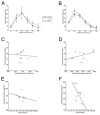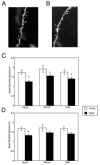Protein kinase C activity is associated with prefrontal cortical decline in aging
- PMID: 17919783
- PMCID: PMC2711775
- DOI: 10.1016/j.neurobiolaging.2007.08.020
Protein kinase C activity is associated with prefrontal cortical decline in aging
Abstract
Aging is associated with deficiencies in the prefrontal cortex, including working memory impairment and compromised integrity of neuronal dendrites. Although protein kinase C (PKC) is implicated in structural plasticity, and overactivation of PKC results in working memory impairments in young animals, the role of PKC in prefrontal cortical impairments in the aged has not been examined. This study provides the first evidence that PKC activity is associated with prefrontal cortical dysfunction in aging. Pharmacological inhibition of PKC with chelerythrine rescued working memory impairments in aged rats and enhanced working memory in aged rhesus monkeys. Improvement correlated with age, with older monkeys demonstrating a greater degree of improvement following PKC inhibition. Furthermore, PKC activity within the prefrontal cortex was inversely correlated with the length of basal dendrites of prefrontal cortical neurons, as well as with working memory performance in aged rats. Together these findings indicate that PKC is dysregulated in aged animals and that PKC inhibitors may be useful in the treatment of cognitive deficits in the elderly.
Figures




References
-
- Ando S, Ohashi Y. Longitudinal study on age-related changes of working and reference memory in the rat. Neurosci Lett. 1991;128:17–20. - PubMed
-
- Arnaiz SL, D’Amico G, Paglia N, Arismendi M, Basso N, del Rosario Lores Arnaiz M. Enriched environment, nitric oxide production and synaptic plasticity prevent the aging-dependent impairment of spatial cognition. Mol Aspects Med. 2004;25:91–101. - PubMed
-
- Barnes CA, Mizumori SJ, Lovinger DM, Sheu FS, Murakami K, Chan SY, Linden DJ, Nelson RB, Routtenberg A. Selective decline in protein F1 phosphorylation in hippocampus of senescent rats. Neurobiol Aging. 1988;9:393–8. - PubMed
Publication types
MeSH terms
Substances
Grants and funding
LinkOut - more resources
Full Text Sources
Medical

